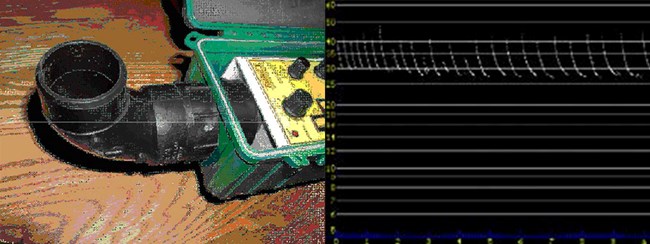Last updated: May 10, 2018
Article
Bat Inventory of Muir Woods National Monument

NPS / Jessica Weinberg McClosky
Importance
Bats are both economically and ecologically important animals, providing ecosystem services such as pollination and predation of insects. Muir Woods National Monument contains natural features, such as redwoods, Douglas fir trees, and Redwood Creek, which make suitable roosting and foraging habitat for numerous bat species.
Biodiversity of bats in the U.S. is relatively low (i.e. 45 species) in comparison to other taxonomic groups. California's central coast is known to support 17 species, nine of which have special status under state or federal law, as they are believed to be at risk. Most bat species are difficult to study in the wild because of their nocturnal foraging and cryptic, inaccessible roost sites. In general, bat populations are believed to be declining. The declines are likely due to direct and indirect human impacts, primarily through destruction of foraging and roosting sites. Most species also have very low reproductive rates, resulting in long recovery periods after population declines. In addition, many populations are constrained by a limited number of specific roosting sites for a large number of individuals. By identifying which species of bats use habitats in Muir Woods and how they use them, bat inventories can help the National Park Service manage for the coexistence of bats and human visitors.

NPS
Inventory Methods
Between 1999 and 2000, researchers utilized guano trapping, acoustic sampling, mist netting, and radio-tracking to detect bat activity and presence in Muir Woods.
Researchers installed 26 guano traps in redwood hollows to identify roosting sites and to compare use between riparian and upland forest. Guano was collected once a month to evaluate seasonal activity and shifts in roost sites. Trees that showed the most use were mist-netted and acoustically monitored. Mistnetting allows researchers to handle animals to confirm species identification and to assess age, sex, and reproductive status. Researchers opened five mist nets for three hours on 24 nights. Researchers also performed acoustic sampling using an Anabat II bat detector system for 33 nights over a 24 month period.
The Anabat system detects ultrasonic echolocation calls and converts them into time/frequency graphs on a computer. Researchers can use these vocal signature graphs to identify bat species by comparing calls recorded during previous mist-netting to calls recorded from bats visually identified at the time of recording and existing bat vocal signature library databases. In addition, a pilot radio-tracking project tracked three individual bats for 12 days to monitor day roosts and nightly activity.
Inventory Findings
Researchers identified 10 bat species foraging and/or roosting in Muir Woods during the 1999-2000 surveys (Table 1).
• Researchers captured nine species in mist nets and also detected the Mexican free-tailed bat acoustically.
• The Long-eared myotis and Pallid bat, known to occur in redwood forest habitat, were not identified in Muir Woods.
• Hollows in both riparian and upland areas receive regular use by bat species, although in this study bats seemed to select maternity roosts near the stream. This may be a result of particular features of a hollow or proximity to the creek.
• All species except Yuma myotis and hoary bat, notable riparian species, were detected in both riparian and upland habitat.
• Researchers captured silver-haired bats in redwood groves but never in hardwoods.
• Yuma myotis were not captured in the redwoods, although they were acoustically detected. As Yuma myotis are one of the most commonly captured bats in other studies, the low capture rate in Muir Woods may indicate unusually low numbers of the species in this setting.
• Seasonal distribution of bats differs by species. At least five species are probably year-round residents. Interestingly, two of these year-round species at Muir Woods, the western red bat and the silver-haired bat, are migratory in most parts of their range.
• The pilot radio-tracking project revealed that bats most commonly use habitat features associated with old-growth redwoods: bark crevices, anomalous features, and fire-scar hollows. This preliminary data may suggest that bats have more roosting potential in protected old-growth forest than in surrounding second-growth and developed areas.
| Scientific Name | Common Name |
|---|---|
| Myotis yumanensis* | Yuma myotis |
| Myotis thysanodes* | Fringed myotis |
| Myotis californicus | California myotis |
| Myotis volans* | Long-legged myotis |
| Lasionycteris noctivagans | Silver-haired bat |
| Eptesicus fuscus | Big brown bat |
| Lasiurus blossevillii^ | Western red bat |
| Lasiurus cinereus | Hoary bat |
| Corynorhinus (=Plecotus) townsendii**^ | Townsend's big-eared bat |
| Tadarida brasiliensis | Mexican free-tailed bat |
**Both Federal and California Species of Concern
^Forest Service Sensitive Species
Additional Resources
Contact Information
Links
San Francisco Bay Area Inventory & Monitoring Network
Pacific Coast Science & Learning Center
San Francisco Bay Area Network Species Lists - Certified Species lists including residency, abundance, and native/non-native status.
Summary by Alison Williams for San Francisco Bay Area Inventory & Monitoring Network, March 2009.
Download PDF from the NPS Data Store
